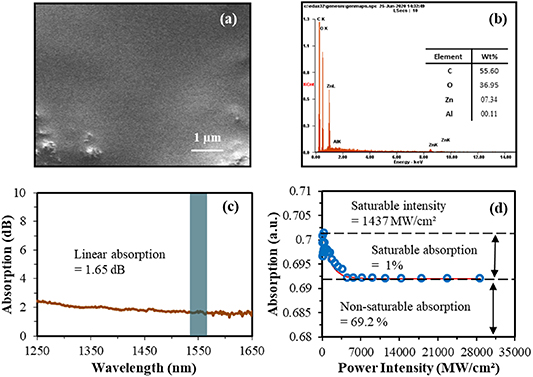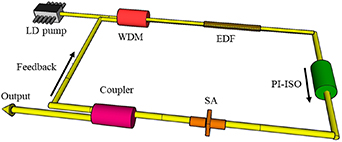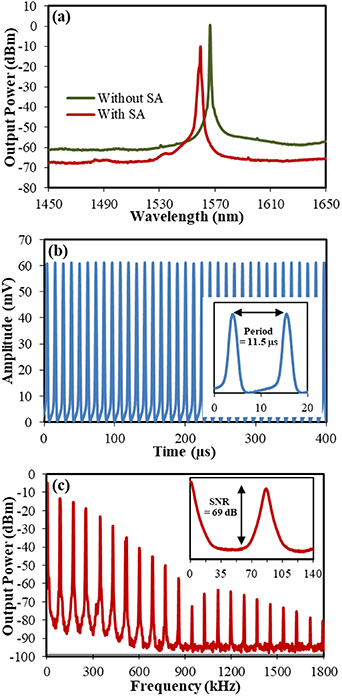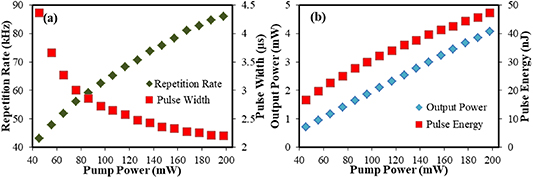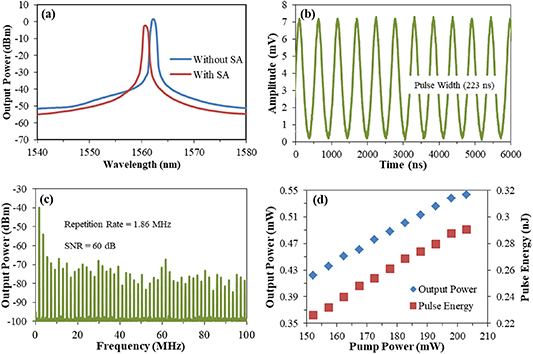Abstract
Transparent conductive oxides (TCOs) are widely integrated in the field of optoelectronics since they are optically transparent and electrically conductive at the same time. Indium tin oxide (ITO) is a well-developed TCO, but due to its high cost, aluminum zinc oxide (AZO) is now emerging as a promising low-cost replacement for ITO. This work reports on AZO thin film prepared with polyvinyl alcohol (PVA) as a host material. The AZO–PVA thin film was incorporated into an erbium-doped fiber laser (EDFL) as a saturable absorber for the first time. Both Q-switched and nanosecond pulse mode-locked operation were experimentally achieved. The Q-switched EDFL operated at the center wavelength of 1559.6 nm, which had the shortest pulse width of 2.2 µs, the maximum repetition rate of 86 kHz and the highest pulse energy of 47.3 nJ. The mode-locked was achieved at the center wavelength of 1560.4 nm.
Export citation and abstract BibTeX RIS
1. Introduction
Pulsed lasers are widely applicable for material processing, optical communication and medical applications [1–4]. Pulsed lasers may be achieved via active or passive means. The active technique requires external modulation of the signal [5], while the passive method utilizes a material known as saturable absorber (SA). For actively modulated lasers, the involvement of electrically driven components makes the setup complex, thus passive methods of achieving the pulsed lasers are preferred. In fiber lasers, passively pulsed operation may be achieved by the incorporation of SA in two different methods, by sandwiching the material in between the fiber ferrules or depositing the SA onto the side-polished fiber [6, 7].
Semiconductor saturable absorber mirrors (SESAMs) were first employed as a SA for femtosecond pulse generation by Keller et al [8]. However, this technique exhibited several drawbacks, such as a complicated setup and limitations in the operational bandwidth. Hence, many materials with strong saturable absorption properties have replaced SESAMs as a pulse generator in a laser cavity. Some extensive studies are reported to explore the potential of SAs based on carbon nanotubes [9], transition metal dichalcogenides [10, 11], topological insulators [12], black phosphorus (BP) [13, 14], and graphene [15, 16]. To date, graphene and BP are frequently developed as SAs. However, graphene suffers from low damage threshold [17], while BP is sensitive to the environment, thus material handling become a matter of concern [18]. There is still search for a suitable SA in terms of performance, stability, sustainability and the SA fabrication cost.
Transparent conductive oxides (TCOs) are widely adopted in optoelectronic devices as they have a rare functionality of being electrically conductive and optical transparent. Indium tin oxide (ITO) is one of the commonly used TCOs [19]. However, due to the relatively high cost and low reserves of indium [20], the researchers came out with aluminum zinc oxide (AZO) as a low-cost solution to ITO. AZO exhibits some excellent optoelectronic properties such as low electrical resistivity (>3.6 × 10−2Ω cm) and high optical transmittance (83%) in visible spectrum [21]. AZO is used in several optoelectronic devices such as light emitting diodes, liquid crystal displays and solar cells [22–25]. These numerous applications of AZO suggest that it can be an interesting material as a SA in an all fiber-based laser cavity.
To date, several works reported TCOs as an SA especially with ITO in a 1 and 1.55 µm laser cavity [26–28]. In contrast, the potential of AZO as a low-cost SA is rarely investigated. Al-Hayali et al incorporated aluminum oxide nanoparticles as a Q-switcher for C-band fiber laser [29]. They generated Q-switching pulses with a minimum pulse width of 2.8 µs corresponding to the repetition rate of 81 kHz. The previous work by Ahmad et al demonstrated the potential of zinc oxide as a SA in an erbium-doped fiber laser (EDFL) [30]. The generated laser owns a maximum repetition rate of 77.2 kHz and the shortest pulse width of 3 µs. So far, only one group has reported the AZO for Q-switching generation in a double-clad EDFL/ytterbium-doped fiber laser, the Q-switched laser was achieved by tuning the pump power in the range of 0.475–1.356 W [31]. The AZO thin film was formed using RF magnetron sputtering which is an expensive fabrication technique [31]. There are no reports that utilized AZO as a pulse initiator in EDFL. In this work, the AZO embedded in polyvinyl alcohol (AZO–PVA) successfully triggered the pulsed lasing operation in the 1.55 µm laser cavity. Q-switching was achieved to operate at a center wavelength of 1559.6 nm, having shortest pulse width of 2.2 μs and highest repetition rate of 86 kHz. The nanosecond mode-locked laser was also realized to operate at the peak wavelength of 1560.4 nm with a maximum average power of 0.543 mW. In the current work, we have experimentally achieved both Q-switched and mode-locked lasers using AZO as a SA. However, the detailed theoretical studies are reported in our previous work, where Q-switched and mode-locked lasers were theoretically analyzed assuming a SA being responsible for the pulse generation [32, 33].
2. AZO–PVA thin film preparation and characterization
In this work, AZO was used as an active material for pulse generation with the PVA as a host polymer, since PVA is a low cost host material which is able to produce high energy fiber lasers [34, 35]. PVA has a simple chemical structure and it has some excellent attributes of strong adhesion and film formation [36]. Figure 1 shows the preparation process of AZO–PVA thin film SA. At first, 1 g of PVA (Sigma Aldrich) was mixed with 100 ml of de-ionized water and stirred at room temperature for 1 h over the magnetic stirrer (CORNING PC-620D). Then a 30 ml of PVA and de-ionized water solution was mixed with 30 mg of 99.9% pure AZO powder purchased from Guangzhou Hongwu Material Technology. After that, the mixture was stirred at room temperature for two days followed with 60 min of ultrasonic bath (GT SONIC) to ensure the proper dispersion of AZO in PVA solution. The AZO–PVA solution was then poured in a 90 mm diameter petri dish and heated for 18 h at 65 °C to form a thin film. In order to avoid any impurities to the fabricated thin film, the solution was properly covered during the mixing and drying process. The AZO–PVA thin film was then peeled and inserted to the EDFL cavity. The microscopic image of AZO–PVA film can be seen in the inset of figure 1.
Figure 1. Preparation of the AZO–PVA thin film.
Download figure:
Standard image High-resolution imageFigure 2 represents the characterization of the prepared AZO–PVA thin film SA. Figure 2(a) shows field emission scanning electron microscopy (FESEM) image of AZO–PVA at 1 μm scale with 5 k× magnification. A homogenous AZO–PVA thin film was seen. Figure 2(b) shows the elemental composition of AZO–PVA SA detected by energy dispersive x-ray spectroscopy (EDS). The proportion of zinc (Zn) was 07.34 weight (wt) %, while oxygen (O) contributes to 36.95 wt% and aluminum (Al) represents 0.11 wt% of the AZO–PVA thin film. A higher wt% contribution from oxygen and the 55.60 wt% of carbon (C) present in the AZO–PVA thin film indicates the proportion of PVA added to the AZO. The appearance of 0.11 wt% aluminum relates to the doping concentration of 0.8 wt% for the maximum transmission and minimum electrical resistivity [23]. For linear absorption, a wide range of low intensity spectrum was analyzed with white light source at the output spectrum ranging from 1250 nm to 1650 nm using optical spectrum analyzer (OSA). The linear absorption of AZO–PVA thin film SA was obtained to be around 1.65 dB at 1550 nm, as shown in figure 2(c). The nonlinear absorption of AZO–PVA thin film SA was measured using a two-arm detector technique. A self-constructed mode-locked laser was first launched to erbium-doped fiber amplifier with a 6.4 ps pulse width, a repetition rate of 0.98 MHz and a wavelength of 1556.1 nm. The amplified output was then controlled with a variable optical attenuator, and a 50:50 coupler was connected to split the output equally. Half of the signal hits the AZO–PVA, while the remaining half propagates through a bare-single mode fiber (SMF). Both outputs were measured using an optical power meter (OPM) under the variation of different pump powers. The data was fitted using equation (1). The linear absorption coefficient (αo), saturable intensity (Isat) and non-saturable absorption (αns) were obtained in figure 2(d). The saturable intensity of the proposed AZO–PVA SA was 1437 MW cm−2 and the nonsaturable absorption was 69.2%, while saturable absorption was measured to be 1%. The saturable absorption can further be enhanced by optimizing the proportion of AZO and PVA in the film formation

Figure 2. Characterization of AZO–PVA thin film: (a) FESEM image, (b) EDS spectrum, (c) linear absorption, and (d) nonlinear absorption.
Download figure:
Standard image High-resolution image3. Experimental setup
Figure 3 shows the proposed EDFL cavity configuration with an AZO–PVA as SA. A 980 nm pump was connected to launch the input pump into the fiber laser cavity through the 980/1550 wavelength division multiplexer (WDM). The output of WDM was connected with erbium-doped fiber (EDF) of 2 m length. EDF had absorption of 23 dB m−1 at 980 nm and core diameter of 4 µm. The numerical aperture of EDF was 0.16. A polarization independent isolator was used inside the cavity to ensure unidirectional propagation of light. A small portion of the newly fabricated AZO–PVA was placed on the tip of the fiber-ferrule, which was pre-applied with an index matching gel for proper adhesion. The AZO–PVA thin film SA was sandwiched between the fiber ferrules followed with the coupler. The total cavity length was measured to be 6 m. To achieve Q-switched operation a 90/10 coupler was used and 90% output from the coupler was set to oscillate back in the cavity. For mode-locked operation, a 100 m SMF was added to optimize the cavity dispersion, and the 95/5 coupler was used to allow more power to oscillate inside the cavity. A 350 MHz oscilloscope (GWINSTEK: GDS-3352) was used at the output to see the pulse train in time domain. A radio frequency spectrum analyzer (RFSA) (ANRITSU: MS2683A) having frequency range of 9 kHz to 7.8 GHz was connected at output to analyze the frequency spectrum. Both the RFSA and oscilloscope were connected via a 1.2 GHz InGaAs fast photodetector (THORLABS: DET01CFC). The OSA (ANRITSU: MS9710C) having operational wavelength range of 600–1750 nm and OPM (THORLABS: PM100D) were connected at the output to see the operational wavelength of fiber laser and to measure the output power of pulsed fiber laser operation, respectively.
Figure 3. Experimental setup of erbium-doped fiber laser.
Download figure:
Standard image High-resolution image4. Results and discussion
In this work, AZO–PVA thin film is experimentally reported as a SA for generation of Q-switched pulse and a nanosecond mode-locked pulse in EDFL cavity. To the best of our knowledge, AZO–PVA thin film is incorporated to all fiber based EDFL cavity for the first time. At first, to exclude the possibility of pulse generation by the host polymer, the bare PVA thin film without AZO was prepared and inserted to the EDFL cavity. The pump power was increased to the maximum limit of laser diode pump. No pulses were observed on the oscilloscope, assuring that there was no contribution in pulse generation by only PVA itself. A continuous-wave (CW) operation was achieved above threshold pump power of 10 mW. While after the insertion of SA, a self-started Q-switched was observed and maintained between 45.3 mW and 198 mW. Figure 4 reports the Q-switched operation of proposed EDFL setup at the pump power of 198 mW. Figure 4(a) shows the optical spectrum at 198 mW pump power, observed on the OSA. The center wavelength peak was observed at 1566.4 nm in CW operation of EDFL before the insertion of SA, while the center wavelength peak shifted to 1559.6 nm after the insertion of SA to the cavity. The SA was responsible for possible shift of center wavelength peak and the Q-switched operation. Figure 4(b) shows a typical pulse train for the time span of 400 μs observed at oscilloscope. At the pump power of 198 mW, the pulse period was 11.5 μs and the shortest pulse width was achieved to be 2.2 μs. A stable bell-shaped pulse was observed during the time frame of 400 μs. There were no fluctuations in pulse amplitude, pulse width and pulse shape, indicating that the Q-switched operation was stable. Figure 4(c) shows frequency spectrum analyzed on RFSA at 198 mW pump power. The pulse repetition rate was 86 kHz with the measured signal-to-noise ratio (SNR) of 69 dB at the fundamental frequency.
Figure 4. Q-switched operation at 198 mW pump power: (a) optical spectrum, (b) time domain pulse train, and (c) frequency spectrum.
Download figure:
Standard image High-resolution imageThe performance of Q-switching with the increase of pump power from 45.3 mW to 198 mW is plotted in figure 5. The variation of repetition rate and pulse width is plotted against the pump power as shown in figure 5(a). The repetition rate increased from 43.17 kHz to 86 kHz while the pulse width decreased from 4.36 μs to 2.2 μs with the increase in pump power from 45.3 mW to 198 mW. This trend of increase in repetition rate and decrease in pulse width with respect to pump power validates the Q-switched operation of EDFL. Figure 5(b) shows the average output power and pulse energy plotted against the pump power increasing from 45.3 mW to 198 mW. The average output power was measured with OPM in an increasing trend from 0.72 mW to 4.1 mW with the slope efficiency of 2.2%, and the calculated pulse energy increased from 16.6 nJ to 47.3 nJ. While the pulse peak power was obtained to be 21.5 mW at pump power of 198 mW. Later the pump power was increased from 198 mW to 300 mW and the CW operation was achieved back, while the pulsed operation re-appeared when the pump power was reduced to 198 mW, assuring that SA was not burnt and it can sustain 300 mW input power. This concludes that optical damage threshold of AZO–PVA thin film SA was beyond the maximum operational threshold pump power of our EDFL cavity, being 300 mW.
Figure 5. Q-switched laser performance: (a) repetition rate and pulse width with pump power and (b) output power and pulse energy with pump power.
Download figure:
Standard image High-resolution imageThe experimental work on Q-switched performance of AZO–PVA thin film as a SA is comparable to some recent works reported on Q-switched operation in EDFL. Recently, Liu et al [37] have reported silicon nanosheets (Si-PVA) based SA for Q-switched where the maximum average output power was 0.89 mW and shortest obtained pulse width was 2.32 μs. Our results are comparable to recent year studies which use PVA as a host polymer [29, 37]. Table 1 sums up the comparison of Q-switched operation including zinc oxide SA and our previous work based on silicon oxycarbide as a SA [30, 37, 38]. The comparison to previous studies show that a higher average output power of 4.1 mW is achieved, contributing to the optimized EDFL configuration. With the addition of 100 m SMF (SMF-28) to the 6 m long cavity, a nanosecond pulsed mode-locked was achieved. Figure 6 shows the mode-locked EDFL operation. Figure 6(a) shows the optical spectrum for mode-locked operation at the pump power of 167.5 mW. The center wavelength peak shifted to the wavelength of 1560.4 nm, due to the absorption contributed by the SA. The typical pulse train observed at oscilloscope recorded a pulse width of 223 ns at pump power of 167.5 mW, as shown in figure 6(b). The autocorrelator (Alnair Labs Corporation HAC-200), was also connected at the output. However, there was no signal detected on the autocorrelator as it can only detect the pulses narrower than 50 ps. Thus, it confirms that the achieved mode-locked laser operated at a nanosecond pulse regime, which can be easily observed on the oscilloscope. The nanosecond pulse width obtained is much shorter as compared to previous work based on zinc oxide as a SA, which achieved a 400 ns pulse width [39]. Figure 6(c) shows the frequency spectrum of mode-locked operation at 167.5 mW pump power with a 100 MHz frequency span. Repetition rate was recorded to be 1.86 MHz which attributes to the length of SMF added to the cavity. The 60 dB SNR of fundamental repetition frequency and appearance of stable pulse repetition in the 100 MHz frequency span assure the mode-locking was stable. The mode-locked pulses were stable at pump power range of 152.2–203.1 mW, with pulse width of 223 ns and repetition rate of 1.86 MHz. In figure 6(d), the output power and pulse energy are plotted with respect to the change in pump power. The maximum recorded average output power and pulse energy were 0.543 mW and 0.29 nJ, respectively.
Figure 6. Mode-locked laser performance: (a) optical spectrum, (b) typical time domain pulse train, (c) frequency spectrum, and (d) average output power and pulse energy against pump power.
Download figure:
Standard image High-resolution imageTable 1. Comparison of Q-switched performance with different SAs.
| SA materials | Pump power (mW) | Operating wavelength (nm) | Maximum repetition rate (kHz) | Shortest pulse width (μs) | Average output power (mW) | References |
|---|---|---|---|---|---|---|
| Silicon nanosheets | 41.5–164 | 1567.1 | 58.7 | 2.32 | 0.17–0.89 | [37] |
| Aluminum oxide | 158–330 | 1560.6 | 81 | 2.8 | 1.2–4.5 | [29] |
| Zinc oxide | 60–360 | 1561 | 77.2 | 3 | 1.2–3 | [30] |
| Silicon oxycarbide | 111.1–198 | 1561.7 | 96.7 | 2.1 | 1.6–2.4 | [38] |
| Aluminum zinc oxide | 45.3–198 | 1559.6 | 86 | 2.2 | 0.72–4.1 | This work |
5. Conclusion
A newly developed, AZO–PVA thin film was used as a SA in the EDFL cavity. The SA showed modulation depth of 1.0% and the linear absorption of 1.65 dB. A stable Q-switched and a nanosecond pulsed mode-locked was achieved with the SA. A self-started Q-switched appeared within the pump power of 45–198 mW, the pulsed laser's operating wavelength was 1559.6 nm, the shortest pulse width was 2.2 μs, the average output power was 4.1 mW, and the pulse energy was 47.3 nJ, respectively. Nanosecond pulse mode-locked was achieved at the operating wavelength of 1560.4 nm. This report paves a way for further investigation on AZO–PVA thin film, such as picosecond pulse generation, femtosecond pulse generation, soliton mode-locking and multi-wavelength Q-switching.
Acknowledgments
The research was supported by Research Group Scheme, Airlangga University (Grant No.: 346/UN3/2020).




